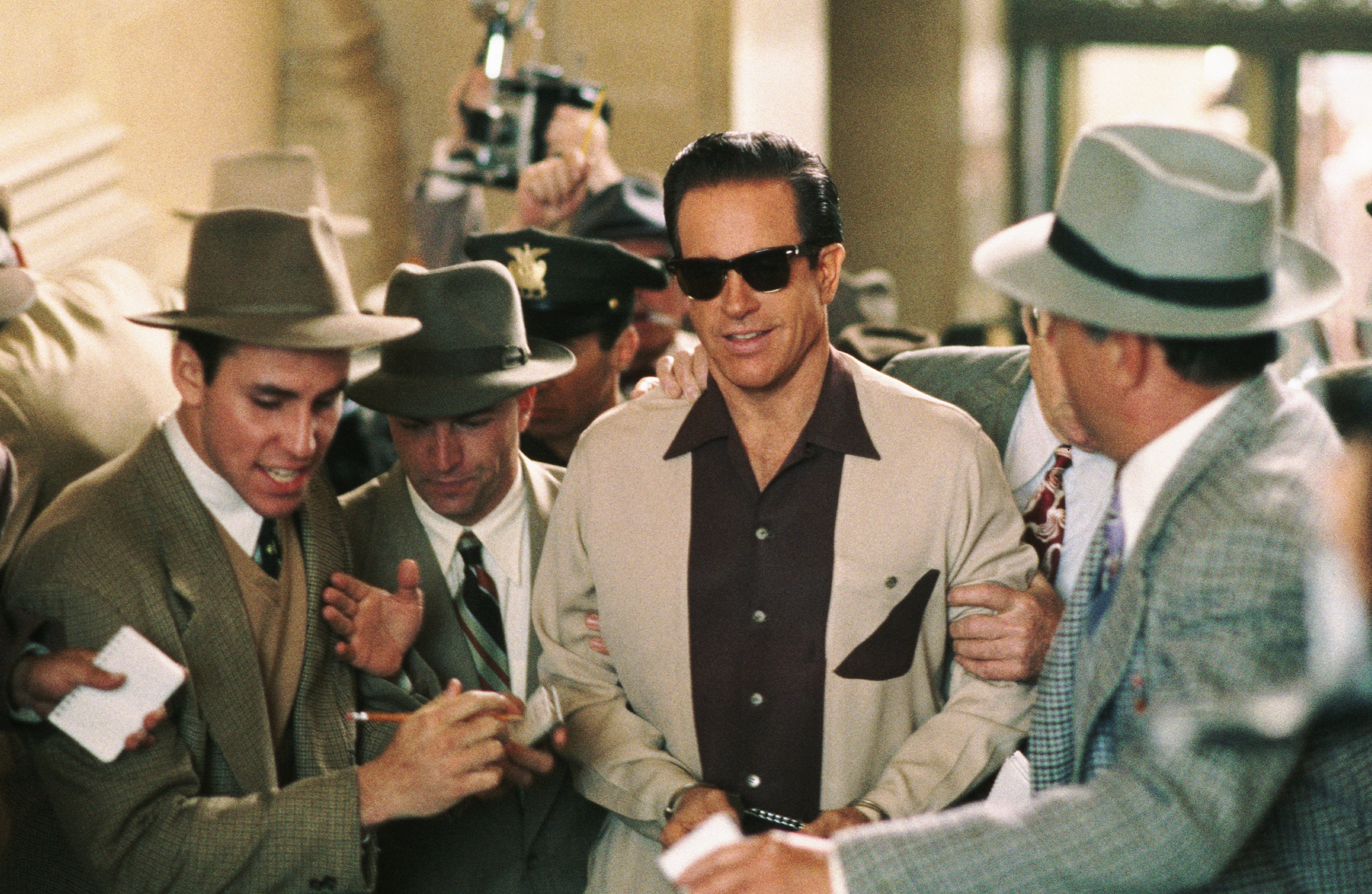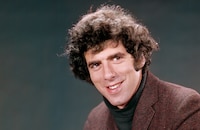Bugsy

Brief Synopsis
Cast & Crew
Barry Levinson
Warren Beatty
Annette Bening
Harvey Keitel
Ben Kingsley
Stefanie Mason
Film Details
Technical Specs
Synopsis
Story about former mob boss Bugsy Siegel, whose love for Virginia Hill motivated him to create the Flamingo Hotel and, later, the gambling mecca of Las Vegas.
Director

Barry Levinson
Cast

Warren Beatty
Annette Bening

Harvey Keitel

Ben Kingsley
Stefanie Mason
Ray Mckinnon
Paul Roache
Don Calfa
Steven Maines
Clive Rosengren
Albina Boccicchio
Gary Mcgurk
Fred Lehto
Michael Sollenberger
Hal Melia
Robert Greenfield
Julie Christensen
Eric Christmas
James Toback

Joe Mantegna
Bebe Neuwirth
Richard C. Sarafian
Joe Baker
Peter Giuliano
Bruce E Morrow

Robert Beltran
Joseph S Roman
Cathleen Crone
Debrah Farentino
John C Moskoff
Lewis Van Bergen
Jamie Angell
Kal David
Wendy Phillips
Kimberly Mccullough
Gerard Joseph Mckenna
Lloyd Baskin

Elliott Gould
Anthony F Russell
Robert Glaudini
Bryan Davis Smith
Traci Lind
Devera Marcus
Ralph Tabakin
Don Carrara
Ksenia Prohaska
Wendie Malick
Tommy Townsend
Andy Romano
Susan Rumor
Carmine Caridi
Gian-carlo Scandiuzzi
Austin Kelly
David H Hebble
Bill Graham
Michael Kenner
Crew
Henry Alvarez
C J Appel
Harold Arlen
Kevin S Arnold
Steve Arnold
Paige Augustine
Craig B Ayers
Paul Babin
Mike Balker
George Bamber
Mario Bauza
Warren Beatty
Richard Beggs
Richard Beggs
Laurie Bernard
Juel Bestrop
John Blackburn
Martin Block
Rube Bloom
Thomas Bookout
Gloria S Borders
Rob Bottin
Christopher Boyes
Jack Brooks
Billy Burton
Billy Burton
Willie Burton
Norman Arthur Burza
Randy Cantor
Hoagy Carmichael
Linda Cathey
Ellen Chenoweth
James Clark
Allegra Clegg
Joseph Cosko
Elise Couvillion
Michael A Crowley
Hallie D'amore
Blair Daily
Mark Daily
Kate Davey
Allen Daviau
Mack David
Michael Davison
B G Decurtis
Ernesto Decurtis
Sara B Dee
Enrico Demelis
Robert E Denne
Robert Deschane
Alberto Dominguez
Tommy Dorsey
Phil Downey
Eric Engler
Jennifer Erskine
Redd Evans
Charles Faithorn
Noreen Farrell
Fernando Favila
Robert Fechtman
Dennis Fill
Kelley Finn
Jim Flamberg
Jim Flamberg
Stacey Foiles
Cindy Franke
Clare Freeman
Jodi Fuchs
Justin Garcia
Marvin Gardner
Dennis Gassner
Claire Gaul
Ira Gershwin
Jay Gianukos
Rosario Giuliani
Peter Giuliano
Robert J Goldstein
Tom Griep
Joseph F Griffith
Rainer Gruetzmacher
Scott Guitteau
Lynda Gurasich
Michael Gurasich
Nancy Haigh
William G Hall
Cynthia Hamilton
Larry Hand
Robert Wayne Harris
William Harrison
Christine Hebble
J. Roy Helland
Tim Holland
Kelly Householder
Lawrence Hubbs
Ian Hunter
Richard Jeffries
Dean Jennings
David Jobe
Mark Johnson
Tom Johnson
David Katz
Douglas Keith
Kathryn Miles Kelly
Michael Kenner
Jerome Kern
Hael Kobayashi
Martin Kohn
Kim K Kono
Alex Kramer
Rande Laiderman
Carol Larkin
Christopher B Lawrence
Peggy Lee
Milton Leeds
Barry Levinson
Marvin E. Lewis
Stu Linder
Tinker Linville
Carlane Passman Little
George L. Little
Frank Loesser
Thomas L Lupo
Guy A Maclaury
David Mann
Dan Marrow
Joel Marrow
Robert Marty
Allan Mason
William R Mayberry
Joe Mccoy
Leslie Mcdonald
James Mcgeachy
Shawn Mckay
Johnny Mercer
Johnny Mercer
Cheri Minns
Carolyn Mock
Gary Moglovkin
Marnie Moore
Ennio Morricone
Aimee A Morris
John P Morris
Jennifer Morrison Holyfield
Jerry Moss
Matthew W. Mungle
Amanda Nelligan
Amy Ness
Charles J. Newirth
Charles J. Newirth
Reggie Newkirk
Deborah Newman
Phil Olbrantz
Grant Osborn
James J. Passanante
Franco Patrignani
Jane Payne
Dr. Leroy Perry
Bruton R Peterson
Ken Peterson
Flip Phillips
Arthur Pimentel
Clay Pinney
Julie Pitkanen
Willie Radcliff
Dennon Rawles
Sayhber Rawles
Phil Read
Russell J Reilly
Paul M Rohrbaugh
Claire Sanfilippo
Francesco Santucci
Paige Sartorius
Gerald Scaife
Laurel Schneider
Scott Schneider
Dennis R. Scott
James R Shelton
Russell Shinkle
Robert Shoup
Beth Siegel
Robin Skelton
Sunny Skylar
Loren Soman
Peter Sorel
Chris Spellman
Robert Spurlock
Deborah Squires
Jo Stafford
Mark A. Stetson
Dianna Stirpe
Robert Stradling
Karl Suessdorf
Mark Sullivan
Russ Tanaka
Dennie Thorpe
James Toback
Pam Uzzell
Tom Valentine
Ethan Van Der Ryn
Don Vargas
Videos
Movie Clip





Film Details
Technical Specs
Award Wins
Best Art Direction
Best Costume Design
Award Nominations
Best Actor
Best Cinematography
Best Director
Best Original Screenplay
Best Picture
Best Score
Best Supporting Actor
Best Supporting Actor
Articles
Bugsy
In many minds, Bugsy redeemed Beatty's career, rescuing it from the disaster of Dick Tracy (1990). Bugsy's noir is far richer and more complex, a nice complement to what James Toback, who wrote the script for Beatty, saw as the actor's own duality: "Warren combines an elegant and well-cultivated charm with a tensely impacted psychosis. The role gave him a historical person through whom he could express his wild extremes," he said in Suzanne Finstad's biography Warren Beatty.
"I honestly believed until the last minute that he wouldn't do the movie. The script is so far out, so excessive...he went all the way with it," said Toback. The film's camera operator, Joseph Cosko, Jr. recalls that Beatty was ''really involved with it. Who knows, maybe he related to Bugsy Siegel? He was the character."
As in other films that he's produced, Beatty inserted some of his own idiosyncrasies into his role, having Siegel use a tanning reflector and put cucumber slices over his eyes. He also took liberties with certain events in the film, such as the scene where Siegel offers to buy the not-for-sale Beverly Hills mansion of opera singer Lawrence Tibbett. The fictitious event is based on a story that the granddaughter of opera star Lauritz Melchior told about Clark Gable trying to by her grandfather's home on Mulholland. Beatty inserts Melchior's name into the dialogue as a homage to the original source of the scene.
For Beatty, what made Bugsy work was Siegel's love for Virginia Hill: "'Romance runs through most of my movies,' Beatty reflected at the time, 'even going back to Bonnie and Clyde (1967) and McCabe & Mrs. Miller (1971), which I sort of co-wrote, and Heaven Can Wait (1978) and Reds (1981). Because I believe that love can conquer all,"' he said in Finstad's biography.
By all accounts, Hill's and Siegel's relationship was a tumultuous one. A paramour of many organized crime figures, Hill was no shrinking violet and gave Siegel as good as she got. Whether she was working for Siegel or against him is left open to interpretation at the film's end, as in real life. In either case, their pairing was explosive, and the task for Bugsy producers was to find an actress who could create that chemistry with Beatty.
In 1990, when Toback and Levinson were assembling possible choices to play Hill's character, Michelle Pfeiffer was at the top of the list. But Bening's star was on the rise that year, fresh from her successes in a small but memorable role in Milos Forman's Valmont (1989). Beatty would later recall seeing her on the screen in that film and thinking, "That is an amazing woman."
A role in Postcards from the Edge (1990) and her breakthrough performance in The Grifters (1990) sealed the deal. The latter film previewed in Los Angeles just as Beatty was closing in on the final pick for Virginia Hill, and Bening's "it" girl status made her a natural choice for the part, as well as the fact that he had fallen in love with her by their first meeting. According to the biography Warren Beatty by Finstad, the actor declared himself to Bening on the day that they shot their characters' first encounter (at the time, she was linked romantically to Ed Begley, Jr.). Beatty told her, "As much as I'd like to have some sort of relationship with you, I'm not going to bother you with that while we're making the movie."
It didn't exactly turn out that way, but by all accounts the on-set romance between the two stars was incredibly discreet, so much so that director Levinson had no idea, stating "Everybody thinks that's impossible, but it's true. And we were together all the time, the three of us, on the set. But they were never hanging around, kind of whispering in one another's ear, kissing in the corners and stuff, holding hands. They didn't do any of that stuff."
The relationship turned out to be a keeper and the two went on to marry and have four children together. The fate of Bugsy, however, was not as long-lived. Although box-office receipts and acclaim for the film were modest, it did manage to score two of its ten Oscar® nominations: Best Art Direction and Best Costume Design. Beatty, Harvey Keitel and Ben Kingsley all received nominations for their roles, as did Barry Levinson, James Toback and Ennio Morricone for his distinctive score. The film was also nominated for Best Picture and Best Cinematography.
Producers: Warren Beatty, Mark Johnson, Barry Levinson
Director: Barry Levinson
Screenplay: James Toback; Dean Jennings (book "We Only Kill Each Other: The Life and Bad Times of Bugsy Siegel") (research source)
Cinematography: Allen Daviau
Art Direction: Leslie McDonald
Music: Ennio Morricone
Film Editing: Stu Linder
Cast: Warren Beatty (Ben 'Bugsy' Siegel), Annette Bening (Virginia Hill), Harvey Keitel (Mickey Cohen), Ben Kingsley (Meyer Lansky), Elliott Gould (Harry Greenberg), Joe Mantegna (George Raft), Richard Sarafian (Jack Dragna), Bebe Neuwirth (Countess di Frasso), Gian-Carlo Scandiuzzi (Count di Frasso), Wendy Phillips (Esta Siegel), Stefanie Mason (Millicent Siegel), Kimberly McCullough (Barbara Siegel), Andy Romano (Del Webb), Robert Beltran (Alejandro)
C-134m. Letterboxed.
by Emily Soares

Bugsy
Quotes
Trivia
Miscellaneous Notes
Barry Levinson was nominated for the Directors Guild of America's 1991 Outstanding Directorial Achievement Award.
Harvey Keitel was named best supporting actor of 1991 by the National Board of Review for his performances in "Bugsy" (USA/91), "Thelma & Louise" (USA/91) and "Mortal Thoughts" (USA/91).
Voted Best Picture of the Year (1991) by the Los Angeles Film Critics Association. Also cited for Best Director and Best Screenplay. Warren Beatty was 1st runner-up in the category of best actor.
Warren Beatty was named best actor of 1991 by the National Board of Review.
Limited Release in United States December 13, 1991
Released in United States February 1992
Released in United States on Video July 1, 1992
Released in United States Winter December 13, 1991
Wide Release in United States December 20, 1991
Shown at Berlin Film Festival (in competition) February 13-24, 1992.
Received a Golden Globe for Best Film (Drama) from the Hollywood Foreign Press Association.
Began shooting January 21, 1991.
Completed shooting May 31, 1991.
Release expanded in USA February 21, 1992.
Released in United States February 1992 (Shown at Berlin Film Festival (in competition) February 13-24, 1992.)
Limited Release in United States December 13, 1991
Released in United States Winter December 13, 1991
Wide Release in United States December 20, 1991
Released in United States on Video July 1, 1992













